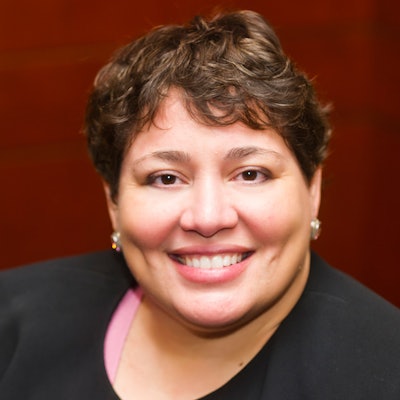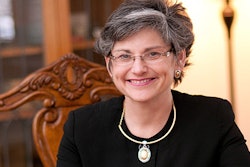For years, it had bubbled under the surface, popping up in conversations at conventions between university presidents, a theoretical, “Wouldn’t it be neat, if..?” Now, the idea has come into fruition: The Alliance of Hispanic Serving Research Universities (HSRU).
 Dr. Deborah Santiago, co-founder and CEO of Excelencia in Education!, an organization focused on improving Latinx student success in higher education.
Dr. Deborah Santiago, co-founder and CEO of Excelencia in Education!, an organization focused on improving Latinx student success in higher education.
Together, these 20 institutions will work to build a national network for Latinx graduate students, helping them find solidarity and belonging.
Currently, fewer than 6% of graduate students are Latinx, according to HSRU, and almost two-thirds of all postsecondary faculty in America are white, according to the National Center for Education Statistics.
“The fact that Latino student enrollment in higher education has increased to about 20%, and faculty representation hasn’t changed much—we’re still between 5% and 7% now—it shows an opportunity here to accelerate students through graduate level so they can become the professors,” said Dr. Deborah Santiago, co-founder and CEO of Excelencia in Education!, an organization focused on improving Latinx student success in higher education.
HSRU has already received grant support. The Andrew E. Mellon Foundation gave $5 million for a project called “Crossing Latinidades: Emerging Scholars and New Comparative Directions,” which will support Latinx humanities students and scholars as they prepare for professoriate roles.
“[The Alliance] sends a message that there are institutions, leaders, and communities committed to advancing the success of others in our community and that is a worthwhile investment,” said Santiago. “Especially for those who don’t see themselves as graduate students or professors, that this is a goal you can or should consider. There’s a message here about the value of Latinos in education that I don’t think we hear enough.”
Dr. Heather Wilson, president of The University of Texas at El Paso (UTEP), is chair of the HSRU. Almost the entirety of UTEP’s student population identifies as a minoritized group, and 83% identify as Hispanic. Thirty-seven percent (37%) of the faculty and 42% of their graduate students are Hispanic.
“I believe we are America’s leading Hispanic-Serving Institution,” said Wilson. “Because UTEP has a high number of doctoral students now, we probably will end up being a source of talent.”
Wilson said that, among all 20 institutions, there are 28 Research Experience for Undergraduate programs. HSRU is hoping to expand on that, creating a mentorship program for undergraduates to spend the summer on research projects, assist them in the process of graduate school applications, and connect them with faculty members. This will be made that much more impactful by the national HSRU network.
 Dr. Heather Wilson, president of The University of Texas at El Paso (UTEP) and chair of the HSRU.
Dr. Heather Wilson, president of The University of Texas at El Paso (UTEP) and chair of the HSRU.
“We have two very specific goals that we’re trying to achieve. We will track that every year and say if we are on track or not,” said Wilson. “And we’ll work together to promulgate lessons learned, help each other, put together proposals to achieve those ends, and hold ourselves accountable.”
In all, seven schools from Texas have joined HSRU, the most from any state. The University of Texas at San Antonio (UTSA) just qualified for R1 status last December. UTSA President Dr. Taylor Eighmy said he was thrilled, not only because they had met an institutional goal in becoming R1, but because it also meant he could join HSRU.
“It was a big deal for everyone. I’ll go out on a limb and say, we represent the future of higher education in the U.S. today. From a demographic perspective and focus, we’re the future,” said Eighmy. “So, I think the Alliance, as it’s constructed now in its infancy, [has] bold goals but important ones.”
Eighmy said he hopes HSRU can help other institutions better and more intentionally serve their Latinx students, becoming not just Hispanic-serving but “Hispanic-thriving.”
Four of California’s schools also joined HSRU, including the University of California (UC), Riverside, whose chancellor, Dr. Kim Wilcox, said being an HSI “has been part of our ethos for decades.”
“We were the first HSI in the UC system,” said Wilcox. “[Joining] was also an obligation we have to the nation, we 20. We take that responsibility seriously.”
Wilcox said UC Riverside was excited by the chance to work nationally on a bigger scale to address the lack of Hispanic faculty members. The HSRU network will connect not just the institutional leaders, but all the faculty and staff, getting everyone on board to improve Latinx graduate and professoriate numbers, said Wilcox, connecting “an awful lot of smart people on campuses, people who spend their whole day thinking about graduate education and diversity issues.”
“You gotta go big or go home,” said Wilcox. “This is a generational challenge, it’s been with us a long time. We can’t keep waiting, we gotta get after it.”




















